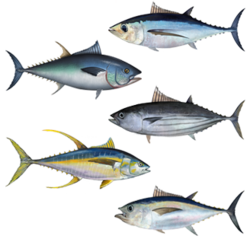Canned tuna
| Tuna | |
|---|---|
 |
|
| Tunas (from top): albacore, Atlantic bluefin, skipjack, yellowfin, bigeye | |
| Scientific classification | |
| Kingdom: | Animalia |
| Phylum: | Chordata |
| Class: | Actinopterygii |
| Order: | Perciformes |
| Family: | Scombridae |
| Subfamily: | Scombrinae |
| Tribe: |
Thunnini Starks, 1910 |
| Genera | |
|
|
| This article is one of a series on |
| Commercial fish |
|---|
| Large pelagic |
|
billfish, bonito mackerel, salmon shark, tuna |
|
|
| Forage |
|
anchovy, herring menhaden, sardine shad, sprat |
|
|
| Demersal |
|
cod, eel, flatfish pollock, ray |
| Mixed |
| carp, tilapia |
|
|
| Nutritional value per 100 g (3.5 oz) | |
|---|---|
| Energy | 830 kJ (200 kcal) |
|
0 g
|
|
|
8 g
|
|
|
29 g
|
|
| Vitamins | |
| Vitamin A equiv. |
(3%)
23 μg |
| Choline |
(6%)
29 mg |
| Vitamin D |
(45%)
269 IU |
| Minerals | |
| Calcium |
(1%)
13 mg |
| Iron |
(11%)
1.4 mg |
| Magnesium |
(9%)
31 mg |
| Phosphorus |
(44%)
311 mg |
| Potassium |
(4%)
207 mg |
| Zinc |
(9%)
0.9 mg |
| Other constituents | |
| Water | 60 g |
|
|
| Percentages are roughly approximated using US recommendations for adults. Source: USDA Nutrient Database |
|
A tuna is a saltwater fish that belongs to the tribe Thunnini, a sub-grouping of the mackerel family (Scombridae) – which together with the tunas, also includes the bonitos, mackerels, and Spanish mackerels. Thunnini comprises fifteen species across five genera, the sizes of which vary greatly, ranging from the bullet tuna (max. length: 50 cm (1.6 ft), weight: 1.8 kg (4 lb)) up to the Atlantic bluefin tuna (max. length: 4.6 m (15 ft), weight: 684 kg (1,508 lb)). The bluefin averages 2 m (6.6 ft), and is believed to live for up to 50 years.
Tuna and mackerel sharks are the only species of fish that can maintain a body temperature higher than that of the surrounding water. An active and agile predator, the tuna has a sleek, streamlined body, and is among the fastest-swimming pelagic fish – the yellowfin tuna, for example, is capable of speeds of up to 75 km/h (47 mph). Found in warm seas, it is extensively fished commercially, and is popular as a game fish. As a result of over-fishing, stocks of some tuna species such as the southern bluefin tuna have been reduced dangerously close to the point of extinction.
The term tuna ultimately derives from Thunnus, the Middle Latin form of the Ancient Greek: θύννος (thýnnos) "tunny-fish" – which is in turn derived from θύνω (thýnō), "rush, dart along".
...
Wikipedia
